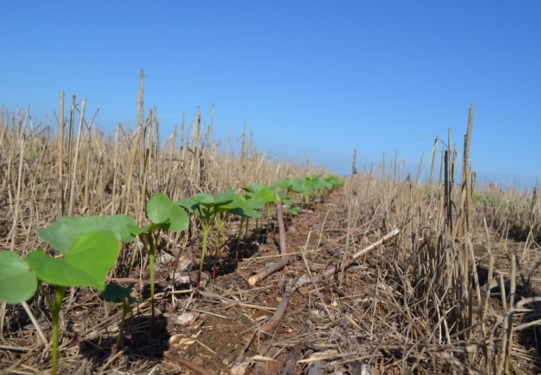
The 2015 cotton crop is off to a great start, although it is running about 2 weeks late. Record May rainfall delayed planting until the end of the month, but most producers were able to get the crop planted by June 20th. May ended up being not only a wet month, but cool also, as the cotton heat unit accumulation at Altus was 27% below normal. This really didn’t matter, as we had virtually nothing planted until about May 27th. June conditions in the first two weeks or so have been excellent, with an occasional thunderstorm producing more rainfall in some areas. Since June 1, cotton heat unit accumulation at Altus has totaled 421through June 21. That is about 11% above normal. What this means is that the crop was planted during the first couple of weeks of June, emerged fairly rapidly and has been growing vigorously ever since. The most advanced cotton in the state of which I am aware is closing in on 5-6 true leaves at this time.
This cotton will be soon be moving into the squaring phase. We have many fields that were planted during the second week of June closing in on 4 true leaves. The value of no-till planting into terminated small grains cover is hard to overstate. Much of the cotton we have been observing has encountered few environmental negatives such as high winds/damaging hail, thrips, etc. This cotton is very robust and appears to have been grown in a greenhouse. The protection afforded by the cover is phenomenal. This cotton was planted June 3rd and the photos were taken on June 18th.
Although we have considerable cotton in very good to excellent condition at this time, not all has fared quite as well. The storm that dumped up to 10 inches of rainfall in Harmon County during the weekend of June 12-14 produced some very high winds, flooding, and hail. Some clean till fields were damaged by this extended stormy period. Typical leaf shredding, bruising, stand loss, etc. was observed in fields that just a few days earlier were immaculate. Growers by and large have done well with weed control through this interesting last two months. We just need to keep up the good work and remember:
1) All Palmer pigweeds should be considered as glyphosate resistant.
2) The best Palmer pigweed management program is to never let them emerge.
3) In order to accomplish #2, effective residual herbicides must be deployed and activated in a timely manner.
Occasionally, growers have concerns that yellow herbicides are just not working anymore. The photograph below shows the results of proper use of a yellow herbicide and the results following no yellow herbicide use. This photo was taken in an Oklahoma cotton field in 2015. Results are essentially to the row.
Click here to see more...